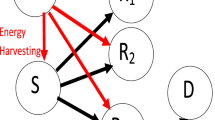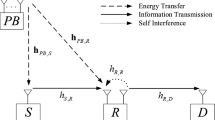Abstract
This paper studies a novel user cooperation method in a wireless powered cooperative communication network (WPCN) in which a pair of distributed terminal users first harvest wireless energy broadcasted by one energy node and then use the harvested energy to transmit information to a destination node (DN). In particular, the two cooperating users exchange their independent information with each other so as to form a virtual antenna array and transmit jointly to the DN. By allowing the users to share their harvested energy to transmit each other’s information, the proposed method can effectively mitigate the inherent user unfairness problem in WPCN, where one user may suffer from very low data rate due to poor energy harvesting performance and high data transmission consumptions. Depending on the availability of channel state information at the transmitters, we consider the two users cooperating using either coherent or non-coherent data transmissions. In both cases, we derive the maximum common throughput achieved by the cooperation schemes through optimizing the time allocation on wireless energy transfer, user message exchange, and joint information transmissions in a fixed-length time slot. We also perform numerical analysis to study the impact of channel conditions on the system performance. By comparing with some existing benchmark schemes, our results demonstrate the effectiveness of the proposed user cooperation in a WPCN under different application scenarios.









Similar content being viewed by others
Notes
We do not consider the energy consumption for information decoding in this paper.
Please refer to the website of Powercast Corp. (http://www.powercastco.com) for detailed product specifications.
References
Krikidis, I., Timotheou, S., Nikolaou, S., Zheng, G., Ng, D. W. K., & Schober, R. (2014). Simultaneous wireless information and power transfer in modern communication systems. IEEE Communications Magazine, 52(11), 104–110.
Bi, S., Ho, C. K., & Zhang, R. (2015). Wireless powered communication: Opportunities and challenges. IEEE Communications Magazine, 53(4), 117–125.
Lu, X., Wang, P., Niyato, D., Kim, D. I., & Han, Z. (2015). Wireless networks with RF energy harvesting: A contemporary survey. IEEE Communications Magazine, 17(2), 757–789.
Bi, S., Zeng, Y., & Zhang, R. (2016). Wireless powered communication networks: An overview. IEEE Wireless Communications, 23(2), 10–18.
Zhou, X., Zhang, R., & Ho, C. K. (2013). Wireless information and power transfer: Architecture design and rate-energy tradeoff. IEEE Transactions on Communications, 61(11), 4754–4767.
Ju, H., & Zhang, R. (2014). Throughput maximization in wireless powered communication networks. IEEE Transactions on Wireless Communications, 13(1), 418–428.
Liu, L., Zhang, R., & Chua, K. C. (2014). Multi-antenna wireless powered communication with energy beamforming. IEEE Transactions on Communications, 62(12), 4349–4361.
Ju, H., & Zhang, R. (2014). Optimal resource allocation in full-duplex wireless powered communication network. IEEE Transactions on Communications, 62(10), 3528–3540.
Huang, K., & Lau, V. K. N. (2014). Enabling wireless power transfer in cellular networks: Architecture, modeling and deployment. IEEE Transactions on Wireless Communications, 13(2), 902–912.
Lee, S., Zhang, R., & Huang, K. B. (2013). Opportunistic wireless energy harvesting in cognitive radio networks. IEEE Transactions on Wireless Communications, 12(9), 4788–4799.
Bi, S., & Zhang, R. (2016). Placement optimization of energy and information access points in wireless powered communication networks. IEEE transactions on wireless communications, 15(3), 2351–2364.
Che, Y., Duan, L., & Zhang, R. (2015). Spatial throughput maximization of wireless powered communication networks. IEEE Journal on Selected Areas in Communications, 33(8), 1534–1548.
Nasir, A. A., Zhou, X., Durrani, S., & Kennedy, R. A. (2015). Wireless-powered relays in cooperative communications: Time-switching relaying protocols and throughput analysis. IEEE Transactions on Communications, 63(5), 1607–1622.
Ju, H., & Zhang, R. (2014). User cooperation in wireless powered communication networks. In Proceedings of IEEE GLOBECOM, Austin, TX, USA, pp. 1430–1435.
Chen, H., Li, Y., Rebelatto, J. L., Uchoa-Filho, B. F., & Vucetic, B. (2015). Harvest-then-cooperate: Wireless-powered cooperative communications. IEEE Transactions on Signal Processing, 63(7), 1700–1711.
Zhou, Z., Zhou, S., Cui, S., & Cui, J. H. (2008). Energy-efficient cooperative communication in a clustered wireless sensor network. IEEE Transactions on Vehicular Technology, 57(6), 3618–3628.
Laneman, J. N., & Wornell, G. W. (2003). Distributed space-time-coded protocols for exploiting cooperative diversity in wireless networks. IEEE Transactions on Information Theory, 49(10), 2415–2425.
Laneman, J. N., Tse, D. N. C., & Wornell, G. W. (2004). Cooperative diversity in wireless networks: Efficient protocols and outage behavior. IEEE Transactions on Information Theory, 50(12), 3062–3080.
Bletsas, A., Shin, H., & Win, M. Z. (2007). Cooperative communications with outage-optimal opportunistic relaying. IEEE Transactions on Wireless Communications, 6(9), 3450–3460.
Patel, C. S., & Stuber, G. L. (2007). Channel estimation for amplify and forward relay based cooperation diversity systems. IEEE Transactions on Wireless Communications, 6(6), 2348–2356.
Alamouti, S. M. (1998). A simple transmit diversity technique for wireless communications. IEEE Journal on Selected Areas in Communications, 16(8), 1451–1458.
Goldsmith, A. (2005). Wireless communications. New York: Cambridge University Press.
Acknowledgements
This work was supported in part by the National Natural Science Foundation of China (project no. 61501303 and 2015A030313552), and the Foundation of Shenzhen City (project no. JCYJ20160307153818306, GJHS20120621143440025 and ZDSY20120612094614154).
Author information
Authors and Affiliations
Corresponding author
Additional information
This work was presented in part at the IEEE International Conference on Telecommunications (ICT), Thessaloniki, Greece, May 16–18, 2016.
Appendices
Appendix 1
Proof of Lemma 4.1
The transmit power of user X is \(P_X=E_X/(t_2+t_4)\), we have from (4) that
where \(c_1\,\triangleq\, E_Xh_{XY}/N_0\), \(c_2\,\triangleq\,t_4\) are both constant. By taking the first and second order derivatives of \(R_X^{(2)}\) in \(t_2\), we have
where \(c_3\triangleq c_1+c_2\). Because \(\frac{d^2R_X^{(2)}}{\mathrm{d}t_2^2}<0\) and \(\lim \limits _{t_2 \rightarrow +\infty } \frac{\mathrm{d}R_X^{(2)}}{\mathrm{d}t_2} = 0\), we can infer that \(\frac{\mathrm{d}R_X^{(2)}}{\mathrm{d}t_2} > 0\) when \(t_2>0\), which leads to the proof of Lemma 4.1 that \(R_X^{(2)}\) increases in \(t_2 \in \left[ 0,T_0\right]\). Similarly, we have \(R_Y^{(3)}\) deceases with \(t_2 \in \left[ 0,T_0\right]\). \(\square\)
Appendix 2
Proof of Lemma 4.2
First of all, we show that both \(t_2\) and \(t_3\) decrease as \(t_4\) increases. Otherwise, we assume without loss of generality that \(t_2\) increases and \(t_3\) decreases when \(t_4\) become larger. We denote the updated values of \(t_2\) and \(t_3\) after \(t_4\) becomes \(\bar{t}_4=t_4+{\Delta }t_4\) as \(\bar{t}_2=t_2+{\Delta } t_2\) and \(\bar{t}_3=t_3-{\Delta } t_3\), respectively, where \({\Delta } t_2,{\Delta } t_3,{\Delta }t_4>0\), and \({\Delta } t_2+ {\Delta }t_4 -{\Delta } t_3 =0\). Besides, we denote the updated values of \(R_X^{(2)}\) and \(R_Y^{(3)}\) as \(\bar{R}_X^{{(2)}}\) and \(\bar{R}_Y^{{(3)}}\), respectively. It can be easily shown from Lemma 4.1 that \(\bar{R}_X^{{(2)}}>\bar{R}_Y^{{(3)}}\) given \(R_X^{(2)} = R_Y^{(3)}\). However, this contradicts with the necessary condition of an optimal solution that requires \(\bar{R}_X^{{(2)}}=\bar{R}_Y^{{(3)}}\). Therefore, we reject our assumption and conclude that both \(t_2\) and \(t_3\) decrease as \(t_4\) increases. Because \(t_2+ t_3 +t_4 =T_1\), we can infer that \(t_2+t_4 = T_1 -t_3\) increases with \(t_4\), so does \(t_3+t_4\). This, together with the result that \(t_2\) (and \(t_3\)) decrease with \(t_4\), leads to the proof that \(R_X^{(2)}\) in (23) (and \(R_Y^{(3)}\) in (24)) is a decreasing function with \(t_4\).
Next, we show that \(R_X^{(4)}\) in (25) increases with \(t_4\). To see this, we let \(\bar{R}_X^{(4)}\) denote the updated value of \(R_X^{(4)}\) after \(t_4\) increases to \(\bar{t}_4 = t_4 + \Delta t_4\). First, we can infer from \(\Delta t_4 = \Delta t_2 + \Delta t_3\) and \(\Delta t_2,\Delta t_3>0\) that \(0< \Delta t_3 \le \Delta t_4\) and \(0<\Delta t_2\le \Delta t_4\) hold. Then, we have
where the first inequality holds because \(0< \Delta t_3 \le \Delta t_4\) and \(0<\Delta t_2\le \Delta t_4\), and the second inequality holds because \(R_X^{(4)}\) increases monotonically with \(t_4\) when \(t_2\) and \(t_3\) are fixed. This leads to the proof that \(R_X^{(4)}\) increases with \(t_4\). \(\square\)
Rights and permissions
About this article
Cite this article
Zhong, M., Bi, S. & Lin, XH. User cooperation for enhanced throughput fairness in wireless powered communication networks. Wireless Netw 23, 1315–1330 (2017). https://doi.org/10.1007/s11276-016-1401-1
Published:
Issue Date:
DOI: https://doi.org/10.1007/s11276-016-1401-1




